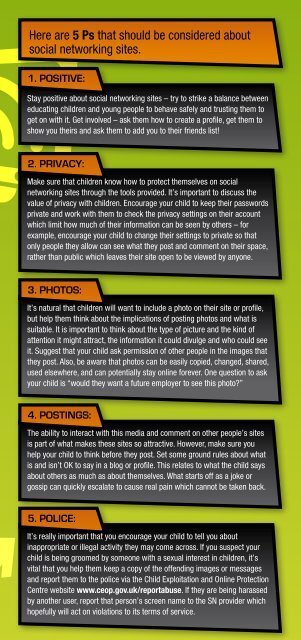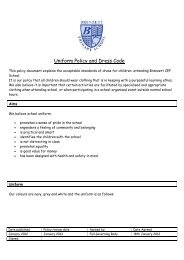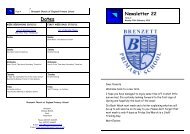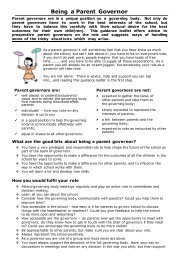Young People & Social Networking Sites - Brenzett Primary School
Young People & Social Networking Sites - Brenzett Primary School
Young People & Social Networking Sites - Brenzett Primary School
You also want an ePaper? Increase the reach of your titles
YUMPU automatically turns print PDFs into web optimized ePapers that Google loves.
Here are 5 Ps that should be considered about<br />
social networking sites.<br />
1. POSITIVE:<br />
Stay positive about social networking sites – try to strike a balance between<br />
educating children and young people to behave safely and trusting them to<br />
get on with it. Get involved – ask them how to create a profile, get them to<br />
show you theirs and ask them to add you to their friends list!<br />
2. PRIVACY:<br />
Make sure that children know how to protect themselves on social<br />
networking sites through the tools provided. It’s important to discuss the<br />
value of privacy with children. Encourage your child to keep their passwords<br />
private and work with them to check the privacy settings on their account<br />
which limit how much of their information can be seen by others – for<br />
example, encourage your child to change their settings to private so that<br />
only people they allow can see what they post and comment on their space,<br />
rather than public which leaves their site open to be viewed by anyone.<br />
3. PHOTOS:<br />
It’s natural that children will want to include a photo on their site or profile,<br />
but help them think about the implications of posting photos and what is<br />
suitable. It is important to think about the type of picture and the kind of<br />
attention it might attract, the information it could divulge and who could see<br />
it. Suggest that your child ask permission of other people in the images that<br />
they post. Also, be aware that photos can be easily copied, changed, shared,<br />
used elsewhere, and can potentially stay online forever. One question to ask<br />
your child is “would they want a future employer to see this photo?”<br />
4. POSTINGS:<br />
The ability to interact with this media and comment on other people’s sites<br />
is part of what makes these sites so attractive. However, make sure you<br />
help your child to think before they post. Set some ground rules about what<br />
is and isn’t OK to say in a blog or profile. This relates to what the child says<br />
about others as much as about themselves. What starts off as a joke or<br />
gossip can quickly escalate to cause real pain which cannot be taken back.<br />
5. POLICE:<br />
It’s really important that you encourage your child to tell you about<br />
inappropriate or illegal activity they may come across. If you suspect your<br />
child is being groomed by someone with a sexual interest in children, it’s<br />
vital that you help them keep a copy of the offending images or messages<br />
and report them to the police via the Child Exploitation and Online Protection<br />
Centre website www.ceop.gov.uk/reportabuse. If they are being harassed<br />
by another user, report that person’s screen name to the SN provider which<br />
hopefully will act on violations to its terms of service.







